Notre Dame demolished Boston College on a snowy senior day, notching a shutout in the final home game for the second straight year. My goal with every recap is to use advanced stats to shine some light on some less obvious results from each game that maybe fans didn’t pick up watching. This is one of the rare opportunities where there aren’t many chances to do that, so instead it’s a celebration of just how thoroughly Notre Dame dominated Boston College and the most fun stats that reflect this massacre.
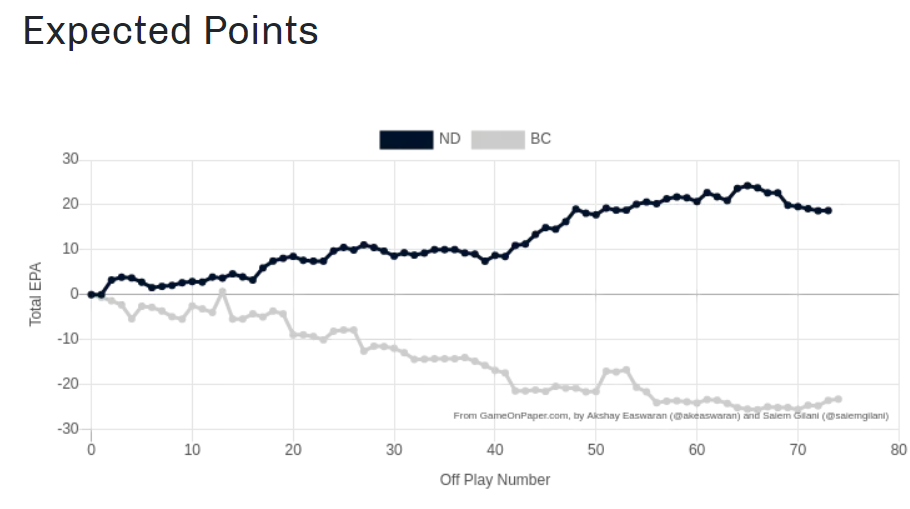
The entire second half classifies as garbage time, with the game firmly out of hand, so 45% of plays were removed from the numbers below. Even garbage time significantly favored Notre Dame as they outgained the Eagles 4.59 – 2.88 in yards per play.
Stats from a few excellent sources – College Football Data, Game On Paper, and often referencing SP+ and FEI numbers. If you get lost, check out this handy advanced stats glossary here or reach out in the comments.
Defense sets the tone again
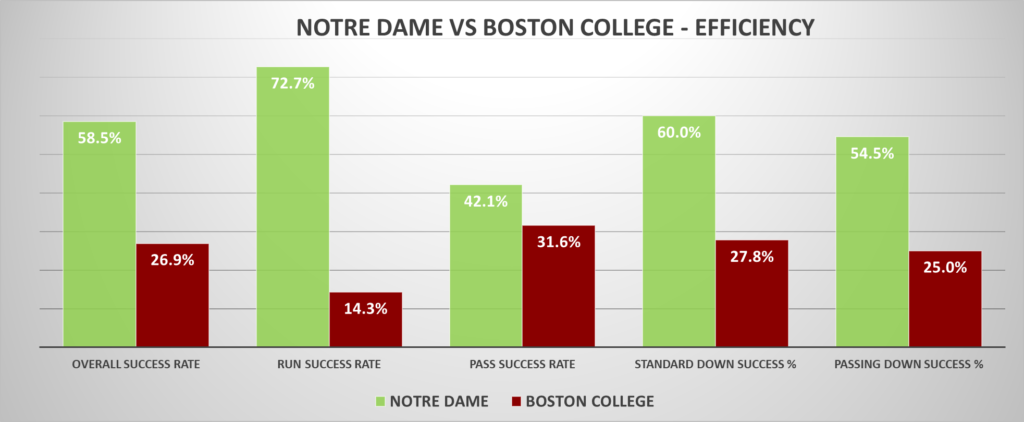
Our old friend (and current BC offensive coordinator) John McNulty never had a prayer in this game. Between graduations and injuries the Eagles offensive line may be in the worst state of any in the P5. The Boston College rushing attack never had a chance (14.3% success, 3 yards per carry) and McNulty barely even tried to run (32% early down runs vs 68% passes) as a result. The prayer was that freshman Emmett Morehead could buy just enough time to take some shots to a still dangerous receiving group to make some things happen.
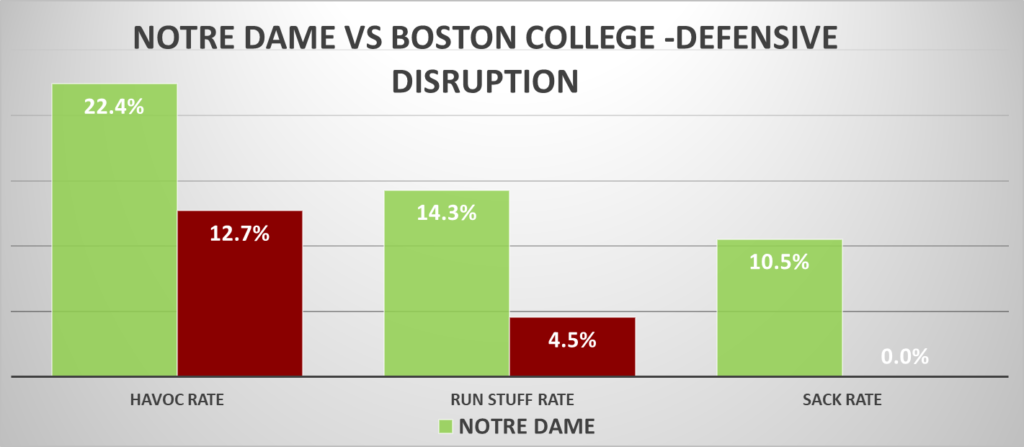
Things happened alright, but only for the guys in gold helmets. Morehead never looked comfortable and was responsible for five BC turnovers, including one on the Eagles only scoring chance of the day and another that should have been returned for a touchdown if not for some typically suspect ACC officiating. Benjamin Morrison continued his torrid November in South Bend, Isaiah Foskey clinched the Irish career sack record at home, and young guys like Jaylen Sneed got to run around and do cool things. After some painful early moments Al Golden seems to have a terrific feel for the pulse of his defense late in the year, and Notre Dame is now 10th nationally in sack rate heading into the showdown with USC.
Rushing dominance fuels the home November offense
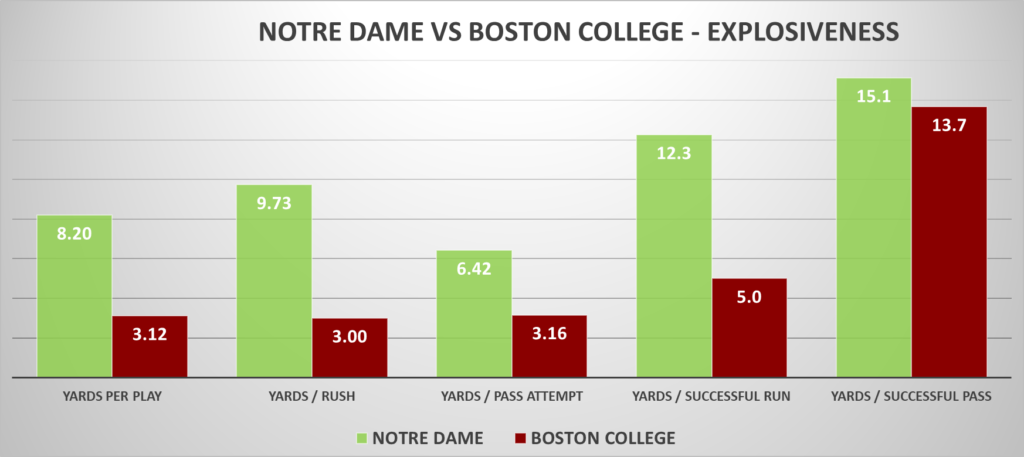
Can we import this weather to Los Angeles this week? What a performance in these conditions by the Irish running game, averaging 9.7 yards per rush and with a 73% success rate. It was an incredibly dominant performance with only one run stuff in 22 rushes before garbage time. A fun fact – Notre Dame’s “unsuccessful runs” in this game averaged the same yards per carry (3.0) as Boston College’s rushes as a whole.

The running back room has been terrifically balanced, even if Audric Estime is clearly the darling of the group looking at the advanced stats (especially now with fumbling issues resolved, knock on wood). Logan Diggs lags slightly behind, but has played the best football of his career in November highlighted by the explosive game against Boston College. While Chris Tyree has been the least productive with his carries, he’s received the most work in the passing game and had strong efficiency despite his stereotype as a speed-only guy. It remains puzzling that with Tyree’s speed he doesn’t break off more long runs – his 26-yarder against Boston College was his longest of the season, and only his 4th run of 12 yards or more.
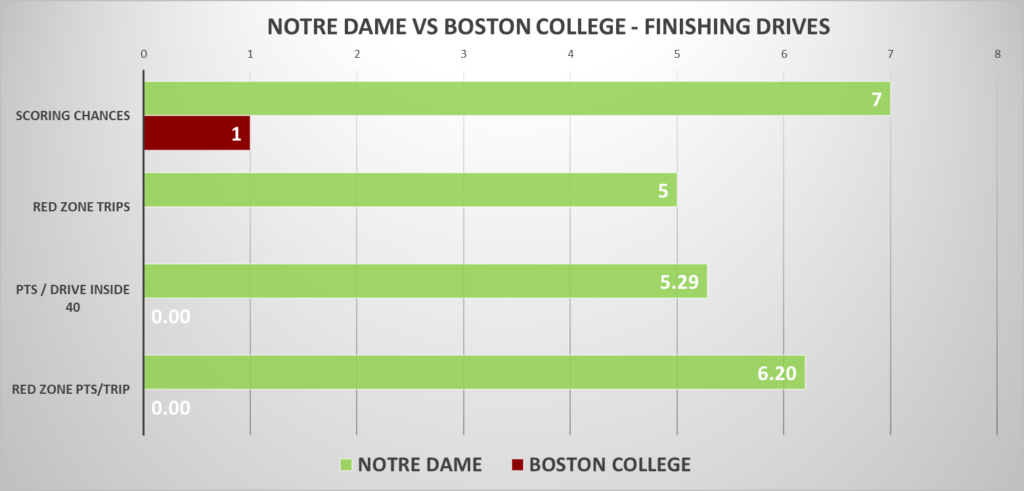
Similar to the Clemson game, with the running game operating on all cylinders Drew Pyne was left without too much responsibility through the air. The Irish remained fairly balanced (55/45 split on early downs toward the running game) and had average efficiency levels through the air despite the conditions. While roles are still unclear, the receiving group feels the deepest its been all year if Tobias Merriweather can return in Los Angeles.
The most dominant win of the year by a landslide
As Notre Dame puts the finishing touches on what has turned into a pretty decent resume, you may be wondering what SP+ and other systems still aren’t too high on the Irish. One significant reason is the lack of blow-outs you’ll see below – it’s been a challenge for this ND team to destroy other teams. And when they have, it’s been significantly aided by turnovers, special teams, and field position advantages that are weighted far less (if at all) in most projection systems to other phases. Finally, the lack of explosiveness for the Irish has meant that even in some games were they were far more efficient, their numbers were less impressive than their success rate advantages would imply.
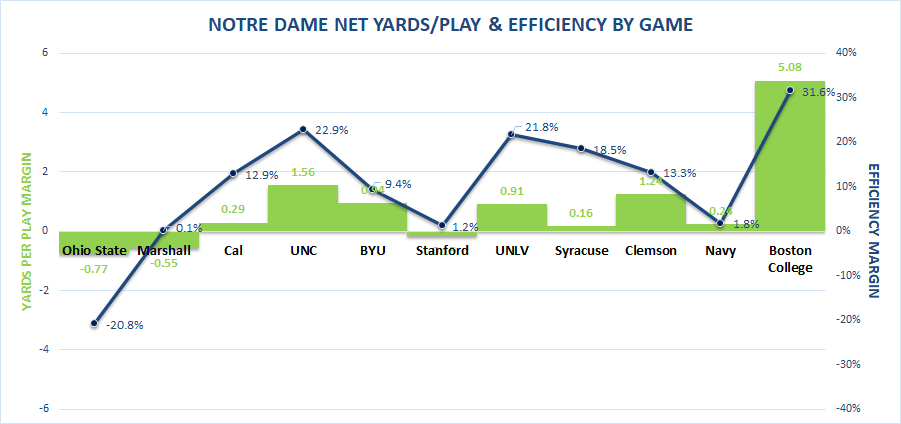
Before Senior Day, Marcus Freeman’s team hadn’t outgained an opponent by more than two yards per play. Against Boston College, they were +5.1! It was also a season high in net efficiency by a significant amount, with Notre Dame +31.6% in success rate after a previous season-high of 22.9% against UNC. These are the blowouts that can make the advanced stat projections fall in love with you, and the lack of of separation at other opportunities (too many to list, including some that turned into losses) still weigh the Irish down in many ratings systems.
Week 12 Composite Ratings!
📈Penn St, Utah, TCU, Kansas St, FSU
📉Oregon, UCLA, Notre Dame, OUSP+ by @ESPN_BillC
FEI by @bcfremeau
Beta_Rank by @beta_rank_fb
FPI by the ESPN Analytics Team
KFord Ratings by @KFordRatings
CFB Winning Edge by @CFBWinningEdge pic.twitter.com/e0beVrgtJR— Nate Manzo (@cfbNate) November 15, 2022
On to USC
Still, the Irish are clearly playing like a top-20 team heading into a showdown with a USC team very much in contention for a playoff spot. It will be a fascinating matchup on so many levels. Caleb Williams and dynamic Trojan offense square up with a top-20 passing defense and the best pass rush they’ve seen all year. A Notre Dame defensive front that has been leaky against the run faces an under the radar SC run game (3rd in rushing success, 1st in EPA/rush).
🏈ADVANCED STATS PREVIEWS: WEEK 13🏈
SATURDAY NIGHT THREAD
NOTRE DAME @ USC pic.twitter.com/zRmzXy5SYL
— parker, u n v e r i f i e d (@statsowar) November 22, 2022
On the other side of the matchup, the two weaker units face off. USC has been able to tread water defensively this year by grabbing turnovers, and are tops in FBS in turnover margin per game by a massive margin (1.82 net per game – 2nd is 1.30). Alex Grinch’s unit is 123rd in defensive success rate allowed (126th vs the rush, 103rd vs the pass) and faces a Notre Dame offense that’s far more efficient than explosive. When team can get more stops? Will the Irish be able to slow down the Trojans like they did Ohio State? Can USC win red zone roulette and keep forcing turnovers?




Comparing ESPN motivated reasoning rankings vs open source rankings there are some weird differences in how they view SEC teams. Unknowable how that could happen.
NEMI – @NateEMiller

IHBMG – @iowahawkblog
